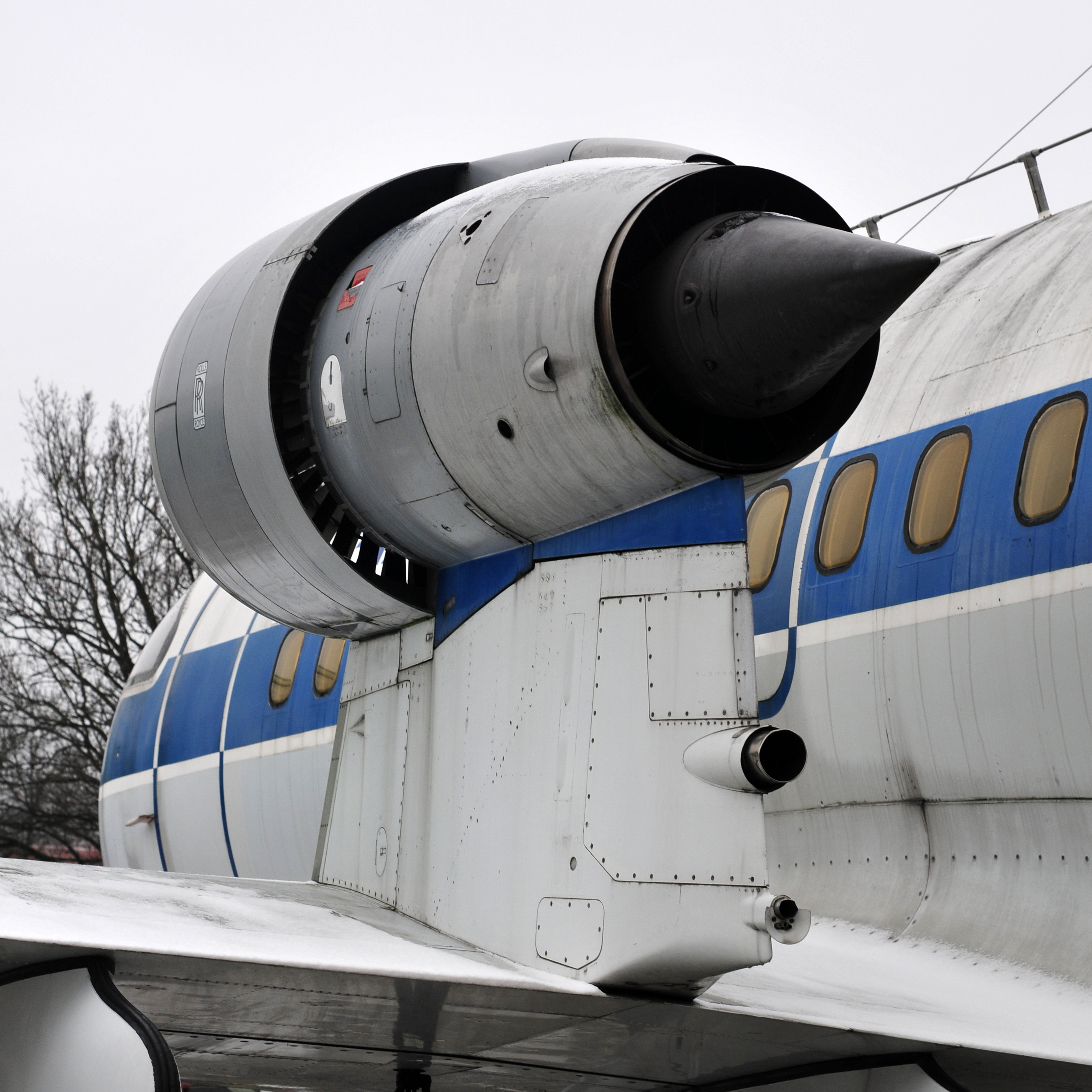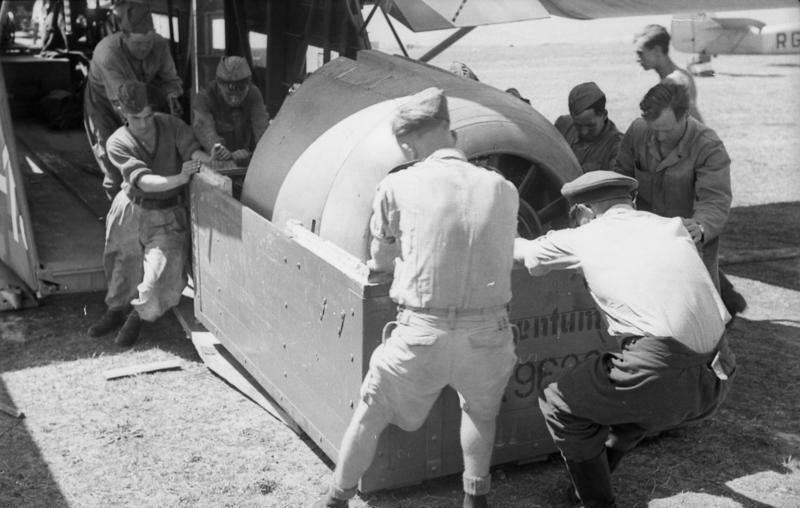|
Rolls-Royce RB.203 Trent
The Rolls-Royce RB.203 Trent was a British medium-bypass turbofan engine of around 10,000lb thrust designed for production in the late 1960s, bearing no relation to the earlier Rolls-Royce RB.50 Trent turboprop or the later high-bypass Rolls-Royce Trent turbofan. Design and development The RB.203 was a private venture engine built on the core of the Rolls-Royce Turbomeca Adour turbofan used in the SEPECAT Jaguar and the later Hawker Siddeley Hawk. The first three-spool engine, it was intended as a civilian replacement for the earlier Rolls-Royce Spey. The RB.203 Trent was a member of an Advanced Technology Engine family of engines with thrusts covering a range from the RB.203 of just under to the RB.207 of up to . The engine designs were launched at the SBAC Farnborough Airshow in September 1966. The Advanced Technology Engine RB.203 embraced the new scalable technologies such as the three-spool architecture, a high pressure annular combustor, the extensive use of composi ... [...More Info...] [...Related Items...] OR: [Wikipedia] [Google] [Baidu] |
WikiProject Aircraft
A WikiProject, or Wikiproject, is a Wikimedia movement affinity group for contributors with shared goals. WikiProjects are prevalent within the largest wiki, Wikipedia, and exist to varying degrees within sister projects such as Wiktionary, Wikiquote, Wikidata, and Wikisource. They also exist in different languages, and translation of articles is a form of their collaboration. During the COVID-19 pandemic, CBS News noted the role of Wikipedia's WikiProject Medicine in maintaining the accuracy of articles related to the disease. Another WikiProject that has drawn attention is WikiProject Women Scientists, which was profiled by '' Smithsonian'' for its efforts to improve coverage of women scientists which the profile noted had "helped increase the number of female scientists on Wikipedia from around 1,600 to over 5,000". On Wikipedia Some Wikipedia WikiProjects are substantial enough to engage in cooperative activities with outside organizations relevant to the field at issue. For e ... [...More Info...] [...Related Items...] OR: [Wikipedia] [Google] [Baidu] |
Society Of British Aerospace Companies
The Society of British Aerospace Companies, formerly Society of British Aircraft Constructors, known as SBAC, was the UK's national trade association representing companies supplying civil air transport, aerospace defence, homeland security and space. As of October 2009 SBAC merged with the Defence Manufacturers Association and the Association of Police and Public Security Suppliers to form the ADS Group. The SBAC organises the Farnborough Airshow. Representation With its regional partners, SBAC represents over 2,600 companies, assisting them in developing new business globally, facilitating innovation and competitiveness and providing regulatory services in technical standards and accreditation. Inside the organisation is the British Aviation Group and the UK Space Agency. History Formation On 29 March 1915 a number of British aircraft manufacturers and industrialists met to arrange a standards body and production pooling system known as the Society of British Aircraft Con ... [...More Info...] [...Related Items...] OR: [Wikipedia] [Google] [Baidu] |
1960s Turbofan Engines
Year 196 ( CXCVI) was a leap year starting on Thursday (link will display the full calendar) of the Julian calendar. At the time, it was known as the Year of the Consulship of Dexter and Messalla (or, less frequently, year 949 ''Ab urbe condita''). The denomination 196 for this year has been used since the early medieval period, when the Anno Domini calendar era became the prevalent method in Europe for naming years. Events By place Roman Empire * Emperor Septimius Severus attempts to assassinate Clodius Albinus but fails, causing Albinus to retaliate militarily. * Emperor Septimius Severus captures and sacks Byzantium; the city is rebuilt and regains its previous prosperity. * In order to assure the support of the Roman legion in Germany on his march to Rome, Clodius Albinus is declared Augustus by his army while crossing Gaul. * Hadrian's wall in Britain is partially destroyed. China * First year of the '' Jian'an era of the Chinese Han Dynasty. * Emperor Xian of ... [...More Info...] [...Related Items...] OR: [Wikipedia] [Google] [Baidu] |
Rolls-Royce Aircraft Gas Turbine Engines
Rolls-Royce (always hyphenated) may refer to: * Rolls-Royce Limited, a British manufacturer of cars and later aero engines, founded in 1906, now defunct Automobiles * Rolls-Royce Motor Cars, the current car manufacturing company incorporated in 1998, a subsidiary of BMW Group * Rolls-Royce Motors, owner of the former car division incorporated in 1973, bought by Vickers in 1980, a subsidiary of Volkswagen Group from 1998 to 2002 * List of Rolls-Royce motor cars Aerospace and nuclear power * Rolls-Royce Holdings plc, an aerospace, power systems and defence company and Rolls-Royce's current principal operating company **Rolls-Royce Deutschland ***Rolls-Royce Power Systems ** Rolls-Royce Marine Power Operations ** Rolls-Royce North America ** Rolls-Royce Turbomeca ** Rolls-Royce Kamawea, now Kamewa ** Rolls-Royce Controls and Data Services See also * Rose Royce, an American soul and R&B group * Roll (other) * Royce (other) Markus Bennett is an American hip-hop re ... [...More Info...] [...Related Items...] OR: [Wikipedia] [Google] [Baidu] |
Flight International
''Flight International'' is a monthly magazine focused on aerospace. Published in the United Kingdom and founded in 1909 as "A Journal devoted to the Interests, Practice, and Progress of Aerial Locomotion and Transport", it is the world's oldest continuously published aviation news magazine. ''Flight International'' is published by DVV Media Group. Competitors include Jane's Information Group and ''Aviation Week''. Former editors of, and contributors include H. F. King, Bill Gunston, John W. R. Taylor and David Learmount. History The founder and first editor of ''Flight'' was Stanley Spooner. He was also the creator and editor of ''The Automotor Journal'', originally titled ''The Automotor Journal and Horseless Vehicle''.Guide To British Industrial History: Biographies: ''Stan ... [...More Info...] [...Related Items...] OR: [Wikipedia] [Google] [Baidu] |
List Of Aircraft Engines
This is an alphabetical list of aircraft engines by manufacturer. 0–9 2si *2si 215 *2si 230 * 2si 430 * 2si 460 *2si 500 * 2si 540 * 2si 690 3W ''Source: RMV'' *3W 106iB2 *3W-110 *3W-112 *3W-170 *3W-210 *3W-220 A Abadal (Francisco Serramalera Abadal) *Abadal Y-12 350/400 hp ABC ''Source: Lumsden.'' * ABC 8 hp * ABC 30hp V-4 * ABC 45hp V-6 * ABC 60hp V-8 * ABC 85hp V-6 * ABC 100hp V-8 * ABC 115 hp * ABC 170hp V-12 * ABC 225hp V-16 *ABC Dragonfly *ABC Gadfly *ABC Gnat *ABC Hornet * ABC Mosquito *ABC Scorpion *ABC Wasp *ABC type 10 APU *ABC type 11 APU ABECO ''Source: RMV'' *ABECO GEM Aberg ''Source: RMV'' *Type Sklenar ABLE ''Source: RMV'', Able Experimental Aircraft Engine Co. (Able Experimental Aircraft Engine Co., Altimizer, Hoverhawk (US)) *ABLE 2275 *ABLE 2500 *ABLE VW x 2 Geared Drive Accurate Automation Corp *Accurate Automation AT-1500 *Accurate Automation AT-1700 Ace (Ace American Engr Corp, Horace Keane Aeroplane Co, North Beac ... [...More Info...] [...Related Items...] OR: [Wikipedia] [Google] [Baidu] |
Rolls-Royce/SNECMA M45H
The Rolls-Royce/SNECMA M45H is an Anglo-French medium bypass ratio turbofan produced specifically for the twin-engined VFW-Fokker 614 aircraft in the early 1970s. The design was started as a collaborative effort between Bristol Siddeley and SNECMA. Design and development The VFW 614 was designed to operate over short sectors with up to a dozen flights a day. The engines were optimized for 30-minute sectors at a cruise altitude of 21,000 feet at Mach 0.65. Only a few minutes would be spent at the cruise rating and most of the flight would be at the higher climb rating or at a descent setting. The engine had a low turbine entry temperature and comparatively low rotational speed. The engine was designed to be uprated without drastic redesign. Three options were water injection (+10% thrust), improved HP turbine (+10% thrust), addition of a zero-stage to the LP compressor (+25% thrust). The M45H-01 was to have a thrust-specific fuel consumption (TSFC) of . The engine was devel ... [...More Info...] [...Related Items...] OR: [Wikipedia] [Google] [Baidu] |
Power-egg
A power-egg is a complete "unitized" modular engine installation, consisting of engine and all ancillary equipment, which can be swapped between suitably designed equipment, with standardised quick-changing attachment points and connectors. In aircraft so designed the power-egg is typically removed before mean time to failure is reached and a fresh one installed, the removed engine then being sent for maintenance. Spare power-eggs may be stored in sealed containers, to be opened when needed. The power-egg or ''Kraftei'' format was used in some German Second World War era aircraft, particularly for twin or multi-engined airframe designs. It existed in two differing formats – the initial ''Motoranlage'' format which used some specialized added components depending on what airframe it was meant for use on, and the ''Triebwerksanlage'' format, a more complete unitization format usually including exhaust and oil cooling systems. Applications Germany Inline and radial engines wer ... [...More Info...] [...Related Items...] OR: [Wikipedia] [Google] [Baidu] |
Nacelle
A nacelle ( ) is a "streamlined body, sized according to what it contains", such as an engine, fuel, or equipment on an aircraft. When attached by a pylon entirely outside the airframe, it is sometimes called a pod, in which case it is attached with a pylon or strut and the engine is known as a podded engine. In some cases—for instance in the typical "Farman" type "pusher" aircraft, or the World War II-era P-38 Lightning—an aircraft cockpit may also be housed in a nacelle, rather than in a conventional fuselage. Etymology Like many aviation terms, the word comes from French, in this case from a word for a small boat. Development The development of the Arado Ar 234, merging the four nacelles into two The Arado Ar 234 was one of the first operational jet aircraft with engines mounted in nacelles. During its development, the four jet engines were merged from having four distinct nacelles, all of which contained their own landing gear wheel, to two nacelles with two engi ... [...More Info...] [...Related Items...] OR: [Wikipedia] [Google] [Baidu] |
Fairchild 228
The Fairchild 228 was a regional jet developed for the United States market by Fairchild Hiller using Fokker F28 sub-assemblies. Design and development In 1967 Fairchild-Hiller sought to develop their own regional jet, the FH-327. Fairchild elected to leverage their relationship with Fokker aircraft in building F.27 aircraft, with a similar arrangement. The plan was to purchase sub-assemblies for the then new F.28 regional jet and assemble them in America into a shortened configuration aircraft with different engines. The Fairchild 228 was to be a 50-passenger twin-engine turbofan regional aircraft. The engines were mounted on the rear of the fuselage, with a swept T-tail arrangement. The wings were equipped with triple-slotted flaps for short-field operations. A new thrust Rolls-Royce RB.203 Trent turbofan was selected to power the aircraft. Fairchild estimated orders of 260-460 aircraft for the US market and 600-800 Internationally. The first sub-assemblies were shipped t ... [...More Info...] [...Related Items...] OR: [Wikipedia] [Google] [Baidu] |
Accessory Drive
The accessory drive is a gearbox that forms part of a gas turbine engine. Although not part of the engine's core, it drives the accessories, fuel pumps, etc., that are otherwise essential for the operation of the engine or the aircraft on which it is mounted. Accessory drives on large engines handle between 400–500 hp. Components Power for the accessory drive is taken from the central shaft linking the turbine and compressor sections of the engine. This requires an internal gearbox that couples the drive to a radial driveshaft or ''towershaft'' that drives an external gearbox. Internal gearbox The design of the internal gearbox is complicated by the heat and small space available in which to connect the driveshaft. It is usually placed between the compressor outlet and the combustor. In turboprops or designs with centrifugal compressors, it may be placed ahead of the compressor. For two-shaft designs, an accessory drive will be taken from the high-pressure sha ... [...More Info...] [...Related Items...] OR: [Wikipedia] [Google] [Baidu] |
.jpg)




